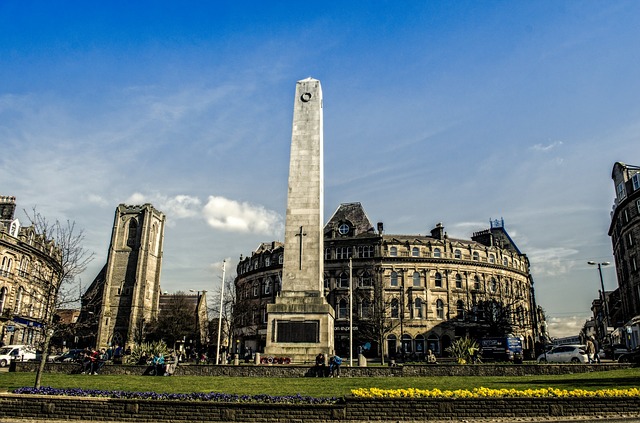By Tim Lambert
Harrogate in the 17th century and 18th century
Until the 17th century, Harrogate was just a quiet hamlet. Then in the late 16th century, a man named William Slingsby drank from a well. He had traveled to several spas and he realised the well water tasted like spa water. Slingsby discovered Tewit Well, which is a chalybeate well (one containing iron). People believed that drinking water from such a well would heal sicknesses. So Harrogate began to grow into a spa town.
Harrogate grew more after 1631 when a man named Dr Michael Stanhope discovered a second well, St John’s Well also known as the Sweet Spa.
During the 17th century, Harrogate slowly grew. By the mid-17th century people bathed in a sulphur well (known as the stinking well) as well as drinking water from the chalybeate wells. Furthermore, in the late 17th century the first inns where visitors could stay were built.
In the late 18th century much public land was enclosed (that is divided up between various people). However, when the land at Harrogate was enclosed in 1770 it was decided to dedicate 200 acres to the public.
Wedderburn House was built in 1786. Harrogate’s Georgian theatre was built in 1788. Meanwhile, a chapel dedicated to St John was built in 1749. In the 19th century, it was replaced by Christ Church, which was consecrated in 1831.
Harrogate in the 19th century
In 1800 Harrogate was still really a large village but it grew rapidly in the 19th century. By 1831 it had a population of around 4,000. By the end of the century, the population of Harrogate was around 25,000.
Bath Hospital (later the Royal Bath Hospital) was built in 1826. The Royal Pump Room was erected in 1842.
In 1841 an Improvement Act was passed. Afterward, a body of men called Improvement Commissioners was elected and they had powers to provide amenities for Harrogate. A water company was formed in 1846 to provide Harrogate with piped water. Harrogate obtained gas light in 1847.
The railway reached Harrogate in 1848. That made it far easier for visitors to reach the town.
In 1884 Harrogate was incorporated (given a mayor and corporation). The first public library opened in 1887. Harrogate gained an electricity supply in 1897.
During the 19th century, Harrogate was still dependent on its spas, which continued to flourish. Another well, the Magnesia Well was discovered in 1895. The Royal Baths opened in 1897.
Harrogate in the 20th century
During the 20th century, Harrogate continued to grow rapidly. In 1901 the population was 26,000. By 1951 the population of Harrogate had reached 50,000.
The first council houses in Harrogate were built in the 1920s and 1930s. Many more council houses were built after 1945. Many private houses were also built.
Harrogate Theatre opened in 1900. In 1903 a hall was built called the Kursaal. It was renamed the Royal Hall in 1918.
A war memorial was erected in Harrogate in 1923. Sun Pavilion and Sun colonnade were built in 1933.
Harrogate’s spas continued to flourish until the 1960s. After 1949 the NHS sent people to the Royal Baths for a cure. However, the NHS stopped funding the treatment in 1968. The Baths closed in 1969. The Royal Pump Room became a museum in 1953. Tewit Well was sealed in 1971 and Harrogate Conference Centre opened in 1982.
Victoria Shopping Centre opened in 1992.

Harrogate in the 21st century
In the early 21st century Harrogate is still a thriving town. The Royal Hall was restored in 2008. In 2023 the population of Harrogate was 75,000.
A Timeline of Harrogate
1631 St John’s Well is discovered
1680 Harrogate is slowly growing as visitors come for its medicinal wells
1749 As the community grows a chapel dedicated to St John Chapel is built
1786 Wedderburn House is built
1788 A theatre is built in Harrogate
1826 Bath Hospital is built
1831 Christ Church is consecrated. By this time Harrogate is growing rapidly. It has a population of 4,000.
1841 An act of parliament forms a body of men with powers to provide amenities for Harrogate
1842 Royal Pump Room is built
1846 A water company is formed
1847 Harrogate gains gas light
1848 The railway reaches Harrogate. Trains boost the growth of the town by making it easier for people to visit.
1884 Harrogate gains a mayor and corporation
1887 The first public library opens in Harrogate
1895 Magnesia Well is discovered
1897 Harrogate gains an electricity supply. The Royal Baths opens.
1900 Harrogate theatre opens
1901 Harrogate is still growing rapidly. It now has a population of about 26,000
1903 Royal Hall is built
1923 A war memorial is erected
1933 Sun Pavilion and Sun Colonnade are built
1951 The population of Harrogate reaches 50,000
1953 The Royal Pump Room becomes a museum
1969 The Baths close
1971 Tewit Well is sealed
1982 Harrogate Conference Centre opens
2008 Royal Hall is restored